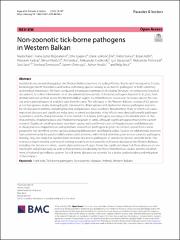Non-zoonotic tick-borne pathogens in Western Balkan

View/
Date
2025Author
Kapo, Naida
Zuber Bogdanović, Ivana
Gagović, Ema
Jurković Žilić, Daria
Sukara, Ratko
Adžić, Bojan
Kadriaj, Përparim
Naletilić, Šimun
Vodica, Ani
Cvetkovikj, Aleksandar
Djadjovski, Igor
Potkonjak, Aleksandar
Savić, Sara
Tomanović, Snežana
Omeragić, Jasmin
Hodžić, Adnan
Beck, Relja
Metadata
Show full item recordAbstract
xodid ticks are present throughout the Western Balkan countries, including Albania, Bosnia and Herzegovina, Croatia,
Montenegro, North Macedonia and Serbia, with many species serving as vectors for pathogens of both veterinary
and medical importance. We have conducted a thorough examination of existing literature, encompassing historical
documents, to collect information on all documented non-zoonotic tick-borne pathogens found in ticks, pets, farm
animals and wild animals across the Western Balkan region. A comprehensive review was necessary due to the scarcity and scattered nature of available data from this area. The tick fauna in the Western Balkans consists of 32 species
across fve genera: Ixodes, Haemaphysalis, Dermacentor, Rhipicephalus and Hyalomma. Various pathogens responsible for diseases in animals, including bacteria and parasites, have also been documented, many of which can cause
important diseases and signifcant reductions in animal productivity. Initial eforts were directed towards pathogen
surveillance and the characterisation of non-zoonotic tick-borne pathogens, resulting in the identifcation of Theileria orientalis, Anaplasma bovis and Anaplasma marginale in cattle, although signifcant gaps remain in the current
research. Studies on small ruminants have been sparse, with confrmed cases of Anaplasma ovis and Babesia ovis
in sheep, but no comprehensive and systematic research on pathogens in goats. In contrast, research on canine
piroplasms has identifed several species, including Babesia canis and Babesia vulpes. Studies on wild animals, however,
have predominantly focused on wild canines and carnivores, with limited attention given to non-zoonotic pathogens.
Notably, only one study has reported non-zoonotic tick-borne pathogens in artiodactyl species and wild felids. This
review is a much needed overview of existing research on non-zoonotic tick-borne diseases in the Western Balkans,
including the historical context, current data and research gaps. Given the signifcant impact of these diseases on animal health and productivity, as well as their potential biodiversity, further comprehensive studies and the establishment of national surveillance systems for tick-borne diseases are essential for a better understanding and mitigation
of their impact.
